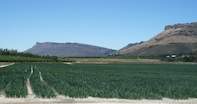
Onion Crop Management
Vegetable Farming in South Africa
Crop Management
For optimal growth do not allow the soil dry out, but bear in mind that onions are sensitive to waterlogging. In fields planted on a slope, take care not to let the plants on the downside become waterlogged as they will turn yellow and remain stunted. Weeding should be done with care between the plants without disturbing the roots or damaging the leaves.
Crop Rotation
A three to four year-rotation programme with non-related crops is recommended to reduce the build-up of soil-borne pests and diseases.
Yield (tonnes per hectare)
Conservative: 15 to 20 tonnes
Average: 25 to 30 tonnes
Good: 40+
Harvesting
In small gardens, harvest the onions when 100% of the leaves have lodged. For bigger areas and commercial plantings, harvest when 50% of the crop has lodged. Once this stage has been reached, do not leave the plants in the soil for too long. Lift onions by loosening the soil with a fork or harvester. Collect the plants, make bundles and tie the leaves together. Hang them from the ceiling of a storeroom to dry. Once the neck of the bulb has dried completely, the leaves can be cut and the bulbs can be stored.
Storage
Once the onions have been dried and cleaned store them in a cool, dry, well-ventilated space. Onions should be mature, well dried and undamaged. Turn the bulbs often so that all sides of the bulb are exposed to air and light at regular intervals. Place them in layers no thicker than 10 cm and remove any bulbs that show signs of rotting.
Pests
Thrips
Diseases
Downy Mildew, purple blotch, pink root, leaf mould, black mould, soft rot, white bulb rot, basal rot
By
Louise Brodie